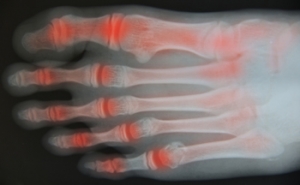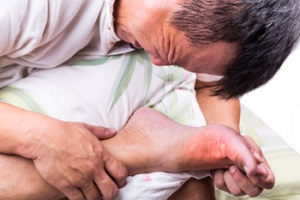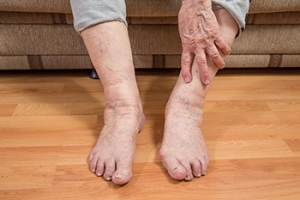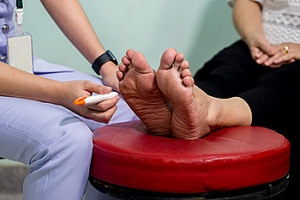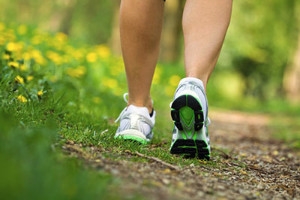Connect With Us
Featured Articles
Super User
Congenital Foot Problems
A congenital foot problem is a problem affecting the feet, toes, and/or ankle that a child is born with. Several issues with a child’s feet can occur congenitally. Such problems include clubfoot, vertical talus, tarsal coalition, polydactyly, macrodactyly, and cleft foot. Some of these problems have a genetic basis, with someone in their family history having a gene causing the condition, and some are simply an anomaly.
The following are specifics about a few of these conditions:
- Clubfoot, also called congenital talipes equinovarus or talipes equinovarus, is When the tendons of the foot shorten, the bones are of an unusual shape, and the Achilles tendon is tight, causing an inward and downward pointing of the foot. The soles of the feet might also face each other. In most cases of clubfoot, both feet are affected. If not treated, the affected child will walk on the sides of their feet or ankles.
- Polydactyly is a condition where the child has more than five fingers or toes on either or both feet. Presentation usually consists of a nubbin or small lump of tissue without a bone, a toe that is partially formed but has no joints, or an extra toe.
- Vertical talus is where the talus bone forms in the wrong position, other bones in the foot do not line up properly, the front of the foot points up, and the bottom of the foot is stiff, has no arch, and usually curves out. This can occur in one or both feet and if left untreated, can lead to serious disability or discomfort as the child grows.
- Tarsal coalition is when there is an abnormal connection of two or more bones in the foot leading to severe, rigid flatfoot. The tarsal bones, located toward the back of the foot and in the heel, are the ones affected. This condition is often present at birth, but signs of the disorder usually come on in early adolescence.
- Cleft foot is a rare condition where the foot has missing toes, a V-shaped cleft, and other anatomical differences. Surgery can often help improve the foot’s function since the heel remains normal and is what is most needed for walking. The main issues with this affliction are whether the affected foot can fit into a shoe and the shape and appearance of the foot.
- Macrodactyly is when the toes are abnormally large due to overgrowth of the underlying bone or soft tissue. Having this condition makes it harder for the child to use the affected foot for certain activities.
How Rheumatoid Arthritis Affects the Feet
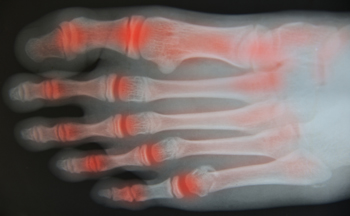
Experts say that 90 percent of people with rheumatoid arthritis (RA) will experience problems with their feet and ankles. Inflammation from this disease causes pain, swelling, redness and a limited range of movement in the joints. In addition, the cartilage, ligaments, and tendons are broken down by the immune system. This, in turn, may cause difficulty in standing and walking for long periods of time. Rheumatoid arthritis can affect the ankle by making it more difficult to go up and down steps. In the hindfoot area, RA impedes the ability to walk on uneven surfaces, such as gravel. Pain generally starts on the outside of the foot, and eventually moves to the arch and the inside of the foot. It may even lead to flat feet as bones shift and become damaged. In the midfoot, the ligaments that support the feet become weaker and cause a collapse of the arch. Deformities in the toes, such as bunions and hammertoe, caused by rheumatoid arthritis may make it difficult not only to walk, but to wear shoes. If you have rheumatoid arthritis, it is a good idea to develop an ongoing relationship with a podiatrist to monitor these and other changes to your feet and ankles.
Because RA affects more than just your joints, including the joints in your feet and ankles, it is important to seek early diagnosis from your podiatrist if you feel like the pain in your feet might be caused by RA. For more information, contact Scott Matthews, DPM, MD of Salem Foot Care . Our doctor will assist you with all of your podiatric concerns.
What Is Rheumatoid Arthritis?
Rheumatoid Arthritis (RA) is an autoimmune disorder in which the body’s own immune system attacks the membranes surrounding the joints. Inflammation of the lining and eventually the destruction of the joint’s cartilage and bone occur, causing severe pain and immobility.
Rheumatoid Arthritis of the Feet
Although RA usually attacks multiple bones and joints throughout the entire body, almost 90 percent of cases result in pain in the foot or ankle area.
Symptoms
- Swelling and pain in the feet
- Stiffness in the feet
- Pain on the ball or sole of feet
- Joint shift and deformation
Diagnosis
Quick diagnosis of RA in the feet is important so that the podiatrist can treat the area effectively. Your doctor will ask you about your medical history, occupation, and lifestyle to determine the origin of the condition. Rheumatoid Factor tests help to determine if someone is affected by the disease.
If you have any questions please feel free to contact our office located in Wikesboro, NC . We offer the newest diagnostic and treatment technologies for all your foot and ankle needs.
Rheumatoid Arthritis in the Feet
Rheumatoid Arthritis is a chronic progressive disease that attacks several joints throughout the body. It is an autoimmune disease in which the body’s immune system mistakenly attacks the joints. As a result, the tissue inside the joints, called synovium, starts to thicken and causes pain around the joints. The synovium is responsible for creating a fluid that lubricates the joints to help them move. Approximately 1.5 million people in the United States have Rheumatoid Arthritis. Women are almost three times as likely to have RA compared to men, and it’s disease usually begins between the ages of 30 and 60. People who have a genetic history of RA are more likely to develop the disease.
Symptoms of RA may include the following sensations in the joints: pain, tenderness, swelling, redness, warmth, stiffness, and loss of range. Swollen joints are a very common symptom for those with the disease. At times, it may be minimal, but it may also be very apparent. Another typical symptom is joint stiffness. Doctors will often use the direction of morning stiffness to measure the severity of a patient’s joint inflammation. Other RA symptoms include limping, anemia, fever, and fatigue.
To diagnose RA, your podiatrist will typically request x-rays to see how much damage there is in the joints. Blood tests may also be performed to show if there are any signs of anemia, or antibodies such as the rheumatoid factor. If you have previously been diagnosed with RA, you should know the disease may spread to your feet and ankles.
There are many non-surgical options that can be used to treat this ailment. Some of these options include physical therapy, foot massages, orthotics, bracing, supportive shoes, and steroid injections. Physical therapy is useful because it will help stretch and strengthen the joints in both the foot and ankle to improve joint function. Massages can help improve blood circulation which will be good for the feet. Choosing proper footwear will allow you to walk with comfortability if you are a sufferer from RA. Lastly, bracing will help stabilize the foot joints, limit deformities and decrease pain.
In severe cases, surgery may be a treatment option that should be considered. For those who cannot walk without experiencing pain and those whose deformities can not be managed with braces, surgery should be considered. Your podiatrist will recommend surgery if he or she believes it will improve your foot biomechanics.
Signs of Gout
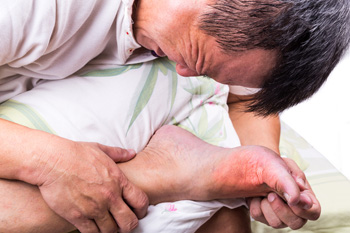
Do you have pain in your big toe? Is your big toe swollen? Did these symptoms occur after being sick or becoming injured? If you answered yes to any of these questions, you may be afflicted with a condition known as gout. Gout is an inflammatory type of arthritis caused by a buildup of uric acid in the blood. Uric acid is naturally produced in the body to help you break down foods that contain purines. Once the purines are broken down, they are cleansed from the body through urine. If something interferes with this process, the buildup of uric acid can turn into urate crystals that collect around soft tissues and joints like the big toe. This can result in inflammation or gout. Men are said to be more susceptible to gout, as are those who eat foods rich in purines. Genetics, health problems like diabetes or high cholesterol, being obese, those who drink alcohol, and those who take diuretics may have an increased risk of developing gout. The pain from gout can be so severe it can interfere with walking and other daily activities. If you think you have gout, make an appointment to see a podiatrist for an accurate diagnosis and a treatment plan.
Gout is a foot condition that requires certain treatment and care. If you are seeking treatment, contact Scott Matthews, DPM, MD from Salem Foot Care . Our doctor will treat your foot and ankle needs.
What Is Gout?
Gout is a type of arthritis caused by a buildup of uric acid in the bloodstream. It often develops in the foot, especially the big toe area, although it can manifest in other parts of the body as well. Gout can make walking and standing very painful and is especially common in diabetics and the obese.
People typically get gout because of a poor diet. Genetic predisposition is also a factor. The children of parents who have had gout frequently have a chance of developing it themselves.
Gout can easily be identified by redness and inflammation of the big toe and the surrounding areas of the foot. Other symptoms include extreme fatigue, joint pain, and running high fevers. Sometimes corticosteroid drugs can be prescribed to treat gout, but the best way to combat this disease is to get more exercise and eat a better diet.
If you have any questions please feel free to contact our office located in Wikesboro, NC . We offer the newest diagnostic and treatment technologies for all your foot and ankle needs.
Foot Structure and Skin May Change in Elderly Feet
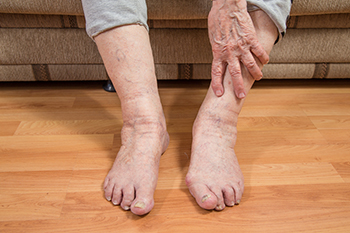 Many elderly people endure foot pain, which may impact mobility and completing daily activities. Research has shown there may be increased soft tissue stiffness in the foot, in addition to having a limited range of motion as one ages. With advanced age, the foot can lose overall strength and may become protonated as a result of reduced joint mobility. The risk of falling may increase, foot pain may develop, and it may be difficult to complete weight bearing activities. Approximately one in five people lose the ability to leave their house because of devastating foot pain. The skin may change thickness, and can add friction to the feet while walking. Recent reviews have confirmed the overall loss of elastin, which can result in thicker and dryer skin on the skin. In summation, the skin condition and foot structure may change in elderly feet, and may cause foot conditions that did not exist in their youth. If you would like more information about how the feet change as the aging process occurs, please consult with a podiatrist.
Many elderly people endure foot pain, which may impact mobility and completing daily activities. Research has shown there may be increased soft tissue stiffness in the foot, in addition to having a limited range of motion as one ages. With advanced age, the foot can lose overall strength and may become protonated as a result of reduced joint mobility. The risk of falling may increase, foot pain may develop, and it may be difficult to complete weight bearing activities. Approximately one in five people lose the ability to leave their house because of devastating foot pain. The skin may change thickness, and can add friction to the feet while walking. Recent reviews have confirmed the overall loss of elastin, which can result in thicker and dryer skin on the skin. In summation, the skin condition and foot structure may change in elderly feet, and may cause foot conditions that did not exist in their youth. If you would like more information about how the feet change as the aging process occurs, please consult with a podiatrist.
If you have any concerns about your feet, contact Scott Matthews, DPM, MD from Salem Foot Care . Our doctor can provide the care you need to keep you pain-free and on your feet.
Biomechanics in Podiatry
Podiatric biomechanics is a particular sector of specialty podiatry with licensed practitioners who are trained to diagnose and treat conditions affecting the foot, ankle and lower leg. Biomechanics deals with the forces that act against the body, causing an interference with the biological structures. It focuses on the movement of the ankle, the foot and the forces that interact with them.
A History of Biomechanics
- Biomechanics dates back to the BC era in Egypt where evidence of professional foot care has been recorded.
- In 1974, biomechanics gained a higher profile from the studies of Merton Root, who claimed that by changing or controlling the forces between the ankle and the foot, corrections or conditions could be implemented to gain strength and coordination in the area.
Modern technological improvements are based on past theories and therapeutic processes that provide a better understanding of podiatric concepts for biomechanics. Computers can provide accurate information about the forces and patterns of the feet and lower legs.
Understanding biomechanics of the feet can help improve and eliminate pain, stopping further stress to the foot.
If you have any questions please feel free to contact our office located in Wikesboro, NC . We offer the newest diagnostic and treatment technologies for all your foot and ankle needs.
Children, Physical Activity, and Sever’s Disease
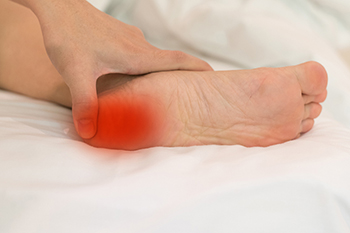
The heel condition that is referred to as Sever’s disease generally affects children and young teenagers who are involved in sporting activities. The heel can often feel sore when Sever’s disease is present, and it may be difficult to walk. It is defined as a condition that affects the growth plate in the heel, and can be confirmed by having a physical examination performed. Relief is often found when the activity that caused the condition is stopped, and the heel is frequently rested. It is important to practice specific stretches once the heel feels better, and this may help to accelerate the recovery process. Many patients choose to wear a heel cushion in their shoe which may be able to provide additional padding. If your child is affected by Sever’s disease, it is advised that a podiatrist be consulted for proper prevention and healing tips.
Sever's disease often occurs in children and teens. If your child is experiencing foot or ankle pain, see Scott Matthews, DPM, MD from Salem Foot Care . Our doctor can treat your child’s foot and ankle needs.
Sever’s Disease
Sever’s disease is also known as calcaneal apophysitis, which is a medical condition that causes heel pain I none or both feet. The disease is known to affect children between the ages of 8 and 14.
Sever’s disease occurs when part of the child’s heel known as the growth plate (calcaneal epiphysis) is attached to the Achilles tendon. This area can suffer injury when the muscles and tendons of the growing foot do not keep pace with bone growth. Therefore, the constant pain which one experiences at the back of the heel will make the child unable to put any weight on the heel. The child is then forced to walk on their toes.
Symptoms
Acute pain – Pain associated with Sever’s disease is usually felt in the heel when the child engages in physical activity such as walking, jumping and or running.
Highly active – Children who are very active are among the most susceptible in experiencing Sever’s disease, because of the stress and tension placed on their feet.
If you have any questions, please feel free to contact our office located in Wikesboro, NC . We offer the newest diagnostic and treatment technologies for all your foot and ankle injuries.
Skin Discoloration and Blisters May Indicate Diabetes
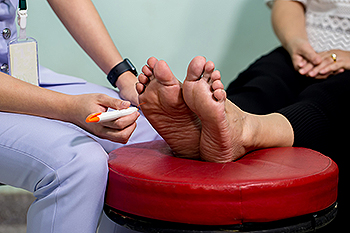 Diabetes is a serious illness that is caused by elevated glucose levels. It is common for diabetic patients to have foot problems, and severe infections can sometimes lead to amputation. Some of the symptoms that diabetics can feel are a numbing and tingling sensation, skin discoloration, and blisters may develop. Diabetic foot care consists of checking the feet daily for any cuts or bruises. This can be done by using a mirror to check the bottom of the feet. Additionally, it is important to control blood sugar levels, and this may be accomplished by eating foods that are healthy. Many patients find that implementing a gentle exercise program can help bring temporary relief from circulation issues that may accompany diabetes. If you are diabetic, it is strongly suggested that you are under the regular care of a podiatrist who can help you to manage this condition.
Diabetes is a serious illness that is caused by elevated glucose levels. It is common for diabetic patients to have foot problems, and severe infections can sometimes lead to amputation. Some of the symptoms that diabetics can feel are a numbing and tingling sensation, skin discoloration, and blisters may develop. Diabetic foot care consists of checking the feet daily for any cuts or bruises. This can be done by using a mirror to check the bottom of the feet. Additionally, it is important to control blood sugar levels, and this may be accomplished by eating foods that are healthy. Many patients find that implementing a gentle exercise program can help bring temporary relief from circulation issues that may accompany diabetes. If you are diabetic, it is strongly suggested that you are under the regular care of a podiatrist who can help you to manage this condition.
Diabetic foot care is important in preventing foot ailments such as ulcers. If you are suffering from diabetes or have any other concerns about your feet, contact Scott Matthews, DPM, MD from Salem Foot Care . Our doctor can provide the care you need to keep you pain-free and on your feet.
Diabetic Foot Care
Diabetes affects millions of people every year. The condition can damage blood vessels in many parts of the body, especially the feet. Because of this, taking care of your feet is essential if you have diabetes, and having a podiatrist help monitor your foot health is highly recommended.
The Importance of Caring for Your Feet
- Routinely inspect your feet for bruises or sores.
- Wear socks that fit your feet comfortably.
- Wear comfortable shoes that provide adequate support.
Patients with diabetes should have their doctor monitor their blood levels, as blood sugar levels play such a huge role in diabetic care. Monitoring these levels on a regular basis is highly advised.
It is always best to inform your healthcare professional of any concerns you may have regarding your feet, especially for diabetic patients. Early treatment and routine foot examinations are keys to maintaining proper health, especially because severe complications can arise if proper treatment is not applied.
If you have any questions please feel free to contact our office located in Wikesboro, NC . We offer the newest diagnostic and treatment technologies for all your foot and ankle needs.
How to Care for Diabetic Foot
Millions of people are affected by diabetes each year. Diabetes damages blood vessels in all parts of the body, especially the feet. The legs and feet may develop slow blood flow, which causes neuropathy, or nerve damage. Once a diabetic patient develops neuropathy, it is important that the feet are well taken care of. Otherwise, the lower limbs may have to be amputated. This only happens in drastic cases, but it shows how seriously diabetic foot care should be taken.
It is very important to always wash and dry the feet thoroughly, especially in between the toes, if you’re a diabetic. Secondly, examining your feet and toes for redness or sores must be done, even if you do not feel pain. You may also want to examine your feet from the bottom. Try to avoid wearing colored socks to prevent infections that may occur from the dye. Well-fitting socks are also highly recommended.
A diabetic’s physician should always monitor their blood levels to test how well blood sugars are being maintained. In addition to giving advice about everyday eating habits and foot care, a physician may prescribe medicine to help with the diabetic patient’s neuropathy. It is also advised to see a podiatrist if experiencing any feet conditions. Toenails may also need to be taken care of by a podiatrist. This prevents patients from cutting too deeply around their cuticles, which can lead to infection.
A person can take care of their feet at home by following the instructions of their physician. Using creams on one’s feet is also an effective way to heal dryness. Proceed with caution when using tools to remove calluses, as severe diabetics may not be able to feel pain on their feet. If any complications arise do not hesitate to contact a podiatrist.
On a daily basis, diabetic feet must be checked. If you are ever concerned about something, contact your health care professional. You never want to wait until a wound becomes too severe to treat. If left untreated, gangrene may develop. Gangrene is a serious infection that can lead to sepsis or amputation. It is also important for diabetics to be on the lookout for ulcers. Ulcers are sores that develop from tissue loss on the skin. They can be quite painful and require intensive treatment. Early treatment and everyday inspection are imperative to staying healthy.
What Kind of Shoes Should I Get if I Am a Fitness Walker?
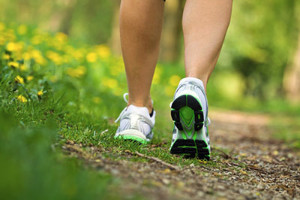 With the preponderance of different types of athletic shoes, it can be hard to know which type of shoe is best for you and your needs. Walking shoes are generally designed for comfort rather than performance. They tend to be stiffer and more cushioned than running shoes. Running shoe designers strive to provide the necessary structure and cushioning with the least amount of weight and seaming that might cause blisters. Fitness walkers should look for shoes that are light, have enough cushioning, do not have a great difference between the heel and toe height, have an undercut rather than a flared heel, and that is flexible or bend easily at the forefoot. Running stores that provide expertise in fitting shoes can help with choosing specific brands that might work best for you. However, visiting a podiatrist for shoe recommendations based on your individual needs at various stages of life is recommended for the long-term health and comfort of your feet.
With the preponderance of different types of athletic shoes, it can be hard to know which type of shoe is best for you and your needs. Walking shoes are generally designed for comfort rather than performance. They tend to be stiffer and more cushioned than running shoes. Running shoe designers strive to provide the necessary structure and cushioning with the least amount of weight and seaming that might cause blisters. Fitness walkers should look for shoes that are light, have enough cushioning, do not have a great difference between the heel and toe height, have an undercut rather than a flared heel, and that is flexible or bend easily at the forefoot. Running stores that provide expertise in fitting shoes can help with choosing specific brands that might work best for you. However, visiting a podiatrist for shoe recommendations based on your individual needs at various stages of life is recommended for the long-term health and comfort of your feet.
For more information about walking shoes versus running shoes, consult with Scott Matthews, DPM, MD from Salem Foot Care . Our doctor can measure your feet to determine what your needs are and help you find an appropriate pair of footwear.
Foot Health: The Differences between Walking & Running Shoes
There are great ways to stay in shape: running and walking are two great exercises to a healthy lifestyle. It is important to know that running shoes and walking shoes are not interchangeable. There is a key difference on how the feet hit the ground when someone is running or walking. This is why one should be aware that a shoe is designed differently for each activity.
You may be asking yourself what the real differences are between walking and running shoes and the answers may shock you.
Differences
Walking doesn’t involve as much stress or impact on the feet as running does. However, this doesn’t mean that you should be any less prepared. When you’re walking, you land on your heels and have your foot roll forward. This rolling motion requires additional support to the feet.
Flexibility – Walking shoes are designed to have soft, flexible soles. This allows the walker to push off easily with each step.
If you have any questions, please feel free to contact our office located in Wikesboro, NC . We offer the newest diagnostic and treatment technologies for all your foot care needs.
Walking Shoes vs. Running Shoes
Although walking shoes and running shoes look similar, they have characteristics that make them different from each other. Runners should avoid running in walking shoes and vice versa. It is very important that you wear the proper footwear for the activity you are going to partake in, for you to avoid injury.
If you are looking to buy a new pair of running shoes, there are certain things you should look out for. One of the main components that makes up a good running shoe is flexibility. You should be able to bend and flex the forefoot of the shoe that you are purchasing. If you can bend the entire shoe in half with ease, this is a sign that the shoe does not have enough structure for your feet. Another feature you should look for is a low heel. Certain running shoes have a low heel to support runners who land on the ball of their feet. Lastly, you should look for the fit of the running shoe. You should visit the best running shoe store in your area to have your feet properly sized for the shoes in the store. Usually, the staff will be able to help recommend the best type of running shoe for your needs.
When you are walking, the body’s weight is evenly distributed on the foot. This influences the design of shoes made for walking. If you are looking to buy a pair of walking shoes, there are different features you should look for to determine which pair of shoes is best for you. Walking shoes should be flexible through the ball of the foot to allow for a greater range of motion through the roll of the forefoot. These shoes also should have greater arch support for the foot. If you plan on walking long distances or on hard surfaces, it is best that you wear shoes that have cushioning.
When trying on a new pair of shoes, the heel should fit snugly without slip. You should shop for shoes after a long walk, since your feet tend to swell throughout the day. Many people have one foot that is a different size than the other, so it is best that you have both feet measured when looking for your true size. You should also beware that sizes vary depending on the shoe brand. A certain size in one brand may be a different size in a different brand. Lastly, you should always walk around in shoes that you plan on buying. This will help you determine whether the shoes are comfortable and if they fit well on your feet.
Always look for good shoe construction when shopping for new sneakers. The upper part of the shoe should allow for adjustment through laces or straps. If you need help with shoe sizing or if you need custom orthotics for your feet, you should make an appointment with your podiatrist for assistance. He or she will be more than happy to help you with your shoe sizing needs.
